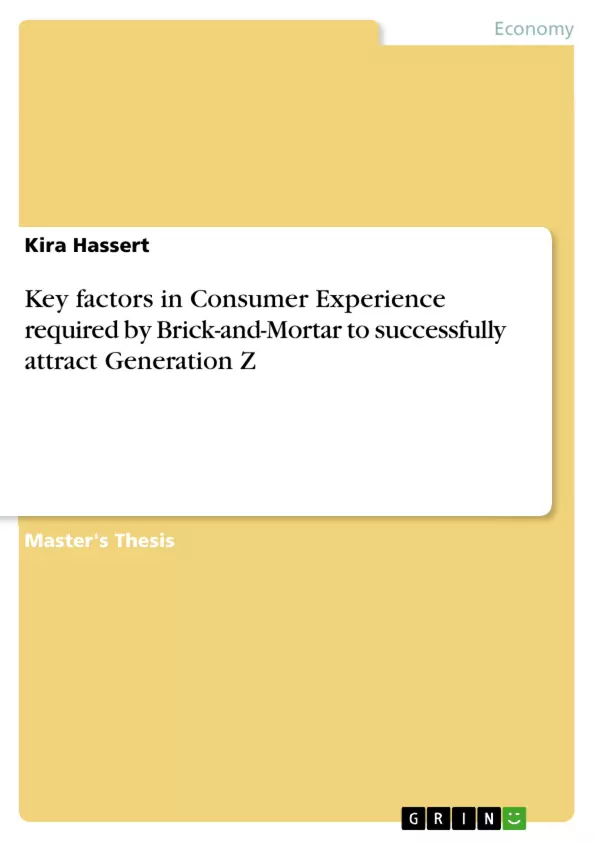Digitalization, globalization, innovation. In an era where the phrase “retail apocalypse” gets shouted across the globe and brick-and-mortar retailers struggle to remain competitive. Rapid technological change is fueling innovation but, is disrupting and upending traditional businesses. Offline retailers realize the need to play catch-up with fast growing online-only retailers that have a data driven approach to steadily improve their operations and understand consumer needs. In a highly competitive industry where the lack of functional differentiation is a catalyst for products and services to become increasingly exchangeable, a competitive advantage can only be created based on customer experiences. Brick-and-mortar stores admit to struggle understanding shopper needs while also facing a new Generation of consumers, that differs to any other known before. The objective of the present work is to determine key success factors in consumer experience required by brick- and mortar in order to successfully attract Generation Z.
Inhaltsverzeichnis (Table of Contents)
- 1. Introduction
- 2. Theoretical Principles and State of Research
- 2.1. Generation Z
- 2.1.1. Definition and Delineation
- 2.1.2. Generational Theories
- 2.1.3. Analyzing Generation Z
- 2.1.3.1. Personality Traits and Core Values
- 2.1.3.2. Shift from Millennials to Generation Z
- 2.1.3.3. Shopping Behavior
- 2.2. Customer Experience
- 2.2.1. Emergence of Experience
- 2.2.2. Customer Experience Management
- 2.2.3. Customer Journey and Touch Points
- 2.2.4. Designing In-store Experiences
- 2.3. Conclusion and Generation of Hypothesis
- 3. Empirical Research
- 3.1. Approach
- 3.2. Qualitative Research
- 3.2.1. Method
- 3.2.2. Results
- 4. Discussion of Results
- 5. Recommendation for the Brick-and-mortar Retailer
- 6. Limitation
- 7. Conclusion and Future Prospect
Zielsetzung und Themenschwerpunkte (Objectives and Key Themes)
This master's thesis aims to investigate the key factors in consumer experience that brick-and-mortar retailers need to successfully attract Generation Z. It explores the characteristics and shopping behavior of Generation Z, examines the concept of customer experience and its management, and analyzes the specific needs of this generation in the context of physical retail environments.
- Characteristics and shopping behavior of Generation Z
- The concept of customer experience and its management
- Key factors in consumer experience that attract Generation Z
- Designing in-store experiences tailored to Generation Z
- Recommendations for brick-and-mortar retailers to attract Generation Z
Zusammenfassung der Kapitel (Chapter Summaries)
The thesis begins by introducing the research topic and outlining the significance of understanding Generation Z's preferences in the retail landscape. Chapter 2 delves into theoretical principles and the existing state of research on Generation Z, customer experience, and their intersection. This chapter explores generational theories, analyzes Generation Z's personality traits and core values, and examines their shopping behavior. It also investigates the emergence and management of customer experience, outlining the customer journey and key touch points. Chapter 3 focuses on the empirical research conducted for this thesis, detailing the qualitative research approach, the methodology used, and the results obtained. The discussion of results in Chapter 4 examines the findings from the empirical research and draws conclusions based on the data collected. This chapter explores how the insights gained can inform the recommendations for brick-and-mortar retailers. Chapter 5 presents specific recommendations for brick-and-mortar retailers based on the research findings, outlining strategies to successfully attract Generation Z.
Schlüsselwörter (Keywords)
The core keywords and focus topics of this thesis include Generation Z, customer experience, brick-and-mortar retail, shopping behavior, in-store experience, consumer behavior, retail strategy, generational marketing, and qualitative research.
- Quote paper
- Kira Hassert (Author), 2018, Key factors in Consumer Experience required by Brick-and-Mortar to successfully attract Generation Z, Munich, GRIN Verlag, https://www.grin.com/document/495620



